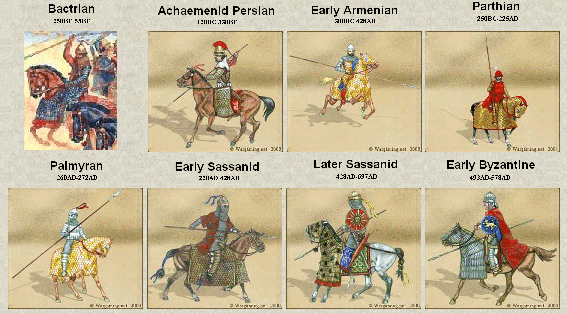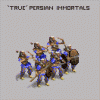Cyclonic
Chieftain
First off: many thanks for the wicked units!
I'm OT here, but you started it
Kryten wrote:
'I very much doubt that I can persuade anyone to downgrade their favourite ancient Civ3 unit just because its more realistic!'
Well, you have persuaded me. But I don't fancy a 2-2-1 upgradeable Immortal at all, and outside of UUs I'd like to keep to the stat distribution, and hence the game balance, of the original; so I'm removing them altogether, except as a flavour graphic - a Saracen Swordsman for Arabic civs perhaps.
But what to do about a Persian UU? My best thought so far is this. A distinguishing feature of a Persian army as opposed to a Greek one was its preponderance of cavalry and relative lack of native (non-mercenary) heavy inf. So I think it's time for an early knight, so to speak
How about:
Saca Cataphract, 3-2-2 UU, requires Horses and Iron, Cost 40, upgrades to Knight. Persian heavy cav fought much like medieval knights, so this unit is an early form of the 4-3-2 Knight. 'Saca' means Scythian: the Saca Cataphracts from the east of the empire around the Jaxartes were present at Gaugamela, where they appear to have fought out an honourable draw with Alex's Companion Cavalry. They can be taken as representative of Persian heavy cav in general (you could just call the unit Heavy Cav if preferred). To keep the uniqueness factor, the freed up 4-2-1 stats would be transferred to the Gallic (costing 40 - 30 was too cheap for such a dangerous unit), and this fits them well enough.
There are problems with this idea. A UU should really be native, but much of the 'Persian' cav was not actually Persian, as the chosen unit suggests. Also, I'm not certain that the Sacas themselves were that heavy: one source I read suggests that at some point they were re-armed with heavier equipment after starting out as a light horse archer type. Further, if Kryten comes out with a Companion Cavalry for the Greeks, I'll have no way to fit it into this scheme without dropping the original stat distribution or changing the Greek UU.
I have some ideas about the Hoplites as well, but that's enough for now. Some of you out there must have grappled with this too - what do you think?
Cyclonic
I'm OT here, but you started it

Kryten wrote:
'I very much doubt that I can persuade anyone to downgrade their favourite ancient Civ3 unit just because its more realistic!'
Well, you have persuaded me. But I don't fancy a 2-2-1 upgradeable Immortal at all, and outside of UUs I'd like to keep to the stat distribution, and hence the game balance, of the original; so I'm removing them altogether, except as a flavour graphic - a Saracen Swordsman for Arabic civs perhaps.
But what to do about a Persian UU? My best thought so far is this. A distinguishing feature of a Persian army as opposed to a Greek one was its preponderance of cavalry and relative lack of native (non-mercenary) heavy inf. So I think it's time for an early knight, so to speak

How about:
Saca Cataphract, 3-2-2 UU, requires Horses and Iron, Cost 40, upgrades to Knight. Persian heavy cav fought much like medieval knights, so this unit is an early form of the 4-3-2 Knight. 'Saca' means Scythian: the Saca Cataphracts from the east of the empire around the Jaxartes were present at Gaugamela, where they appear to have fought out an honourable draw with Alex's Companion Cavalry. They can be taken as representative of Persian heavy cav in general (you could just call the unit Heavy Cav if preferred). To keep the uniqueness factor, the freed up 4-2-1 stats would be transferred to the Gallic (costing 40 - 30 was too cheap for such a dangerous unit), and this fits them well enough.
There are problems with this idea. A UU should really be native, but much of the 'Persian' cav was not actually Persian, as the chosen unit suggests. Also, I'm not certain that the Sacas themselves were that heavy: one source I read suggests that at some point they were re-armed with heavier equipment after starting out as a light horse archer type. Further, if Kryten comes out with a Companion Cavalry for the Greeks, I'll have no way to fit it into this scheme without dropping the original stat distribution or changing the Greek UU.
I have some ideas about the Hoplites as well, but that's enough for now. Some of you out there must have grappled with this too - what do you think?
Cyclonic





 ).
).  )
)



 So your going to make an MF version first? Don't you need the single unit before you can make the Multi?
So your going to make an MF version first? Don't you need the single unit before you can make the Multi? 